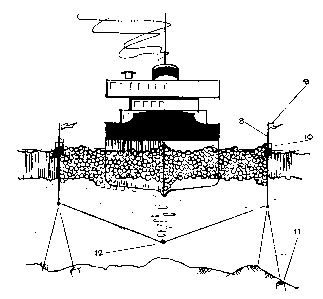Some of the information on this Web page has been provided by external sources. The Government of Canada is not responsible for the accuracy, reliability or currency of the information supplied by external sources. Users wishing to rely upon this information should consult directly with the source of the information. Content provided by external sources is not subject to official languages, privacy and accessibility requirements.
Any discrepancies in the text and image of the Claims and Abstract are due to differing posting times. Text of the Claims and Abstract are posted:
| (12) Patent Application: | (11) CA 2383661 |
|---|---|
| (54) English Title: | HARBOUR ICE CHANNEL |
| (54) French Title: | CHENAL AMENAGE DANS LA GLACE D'UN PORT |
| Status: | Deemed Abandoned and Beyond the Period of Reinstatement - Pending Response to Notice of Disregarded Communication |
| (51) International Patent Classification (IPC): |
|
|---|---|
| (72) Inventors : |
|
| (73) Owners : |
|
| (71) Applicants : |
|
| (74) Agent: | |
| (74) Associate agent: | |
| (45) Issued: | |
| (22) Filed Date: | 2002-05-08 |
| (41) Open to Public Inspection: | 2003-11-08 |
| Availability of licence: | N/A |
| Dedicated to the Public: | N/A |
| (25) Language of filing: | English |
| Patent Cooperation Treaty (PCT): | No |
|---|
| (30) Application Priority Data: | None |
|---|
A means of creating a navigable path, passage, canal, or channel, for marine
craft,
boats, or ships, through solid ice, during seasonal, arctic, or natural winter
freezing
conditions by the use of loose, or captive, hollow, or solid, balls, spheres,
or discs made
of plastic, rubber, metal, wood or wood composite, packed and nested together
at a
specified depth and placed on the surface of the water within the width and
length of a
proposed navigable channel, formed by existing concrete, or steel walls, or by
cutting a
path through solid ice with rotary or chain saws, or creating a passage with
vertical,
floating mesh netting, at the beginning of the winter freeze.
The inventor has established that loose of captive, frozen, closely packed
nested balls,
create a web of interlocking filaments of ice structure between them, but
having no
consistent thickness in any direction, the structure remains weak and
susceptible to
pressure. or direct force and is easily broken up by weight, or the bow of
small harbour
craft. Larger balls create a similarly weak ice structure. Although still
subject to
freezing, continuous use of the channel will change each time to break-up and
churn
the mush of water, ice fragments and moving or sliding balls, ensuring there
is no
impenetrable solid ice barrier to open water. Ball traps at each end of the
channel
determine that very few balls are lost, or drift away.
Note: Claims are shown in the official language in which they were submitted.
Note: Descriptions are shown in the official language in which they were submitted.

2024-08-01:As part of the Next Generation Patents (NGP) transition, the Canadian Patents Database (CPD) now contains a more detailed Event History, which replicates the Event Log of our new back-office solution.
Please note that "Inactive:" events refers to events no longer in use in our new back-office solution.
For a clearer understanding of the status of the application/patent presented on this page, the site Disclaimer , as well as the definitions for Patent , Event History , Maintenance Fee and Payment History should be consulted.
| Description | Date |
|---|---|
| Time Limit for Reversal Expired | 2007-05-08 |
| Application Not Reinstated by Deadline | 2007-05-08 |
| Inactive: Adhoc Request Documented | 2007-02-14 |
| Inactive: Adhoc Request Documented | 2007-02-12 |
| Inactive: Adhoc Request Documented | 2006-11-28 |
| Deemed Abandoned - Failure to Respond to Maintenance Fee Notice | 2006-05-08 |
| Inactive: IPC from MCD | 2006-03-12 |
| Application Published (Open to Public Inspection) | 2003-11-08 |
| Inactive: Cover page published | 2003-11-07 |
| Inactive: IPC assigned | 2002-07-22 |
| Inactive: First IPC assigned | 2002-07-22 |
| Inactive: Office letter | 2002-06-11 |
| Application Received - Regular National | 2002-06-05 |
| Filing Requirements Determined Compliant | 2002-06-05 |
| Inactive: Filing certificate - No RFE (English) | 2002-06-05 |
| Abandonment Date | Reason | Reinstatement Date |
|---|---|---|
| 2006-05-08 |
The last payment was received on 2005-05-04
Note : If the full payment has not been received on or before the date indicated, a further fee may be required which may be one of the following
Please refer to the CIPO Patent Fees web page to see all current fee amounts.
| Fee Type | Anniversary Year | Due Date | Paid Date |
|---|---|---|---|
| Application fee - small | 2002-05-08 | ||
| MF (application, 2nd anniv.) - small | 02 | 2004-05-10 | 2004-03-30 |
| MF (application, 3rd anniv.) - small | 03 | 2005-05-09 | 2005-05-04 |
Note: Records showing the ownership history in alphabetical order.
| Current Owners on Record |
|---|
| WARWICK I. WEBSTER |
| Past Owners on Record |
|---|
| None |